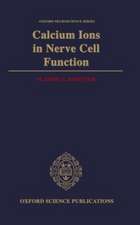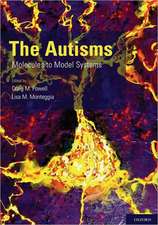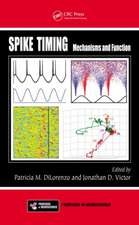Neuroscientific Basis of Dementia
Editat de Chikako Tanaka, Patrick L. McGeer, Yasuo Iharaen Limba Engleză Paperback – 23 oct 2012
| Toate formatele și edițiile | Preț | Express |
|---|---|---|
| Paperback (1) | 389.88 lei 6-8 săpt. | |
| Birkhäuser Basel – 23 oct 2012 | 389.88 lei 6-8 săpt. | |
| Hardback (1) | 654.96 lei 6-8 săpt. | |
| Birkhauser – 30 noi 2000 | 654.96 lei 6-8 săpt. |
Preț: 389.88 lei
Nou
Puncte Express: 585
Preț estimativ în valută:
74.61€ • 77.61$ • 61.60£
74.61€ • 77.61$ • 61.60£
Carte tipărită la comandă
Livrare economică 14-28 aprilie
Preluare comenzi: 021 569.72.76
Specificații
ISBN-13: 9783034894821
ISBN-10: 3034894821
Pagini: 324
Ilustrații: XXI, 298 p.
Dimensiuni: 155 x 235 x 17 mm
Greutate: 0.46 kg
Ediția:Softcover reprint of the original 1st ed. 2001
Editura: Birkhäuser Basel
Colecția Birkhäuser
Locul publicării:Basel, Switzerland
ISBN-10: 3034894821
Pagini: 324
Ilustrații: XXI, 298 p.
Dimensiuni: 155 x 235 x 17 mm
Greutate: 0.46 kg
Ediția:Softcover reprint of the original 1st ed. 2001
Editura: Birkhäuser Basel
Colecția Birkhäuser
Locul publicării:Basel, Switzerland
Public țintă
ResearchCuprins
Special lectures.- A tale of protein kinase C and membrane lipid signaling.- Complement, neuroinflammation and neuronal degeneration in Alzheimer disease.- Memory and its impairment.- Neurobiological mechanisms by which emotional arousal influences long-term memory formation.- Amygdalar damage and memory impairment in Alzheimer’s disease.- Neural substrate for spatial memory in the monkey hippocampus.- Involvement of CaM kinase II and mitogen-activated protein kinase in hippocampal long-term potentiation.- Pathogenesis of dementia — tau.- Transgenic mice overexpressing the shortest human tau isoform develop a progressive tauopathy.- Tau and neurodegenerative disease: genetics and pathogenetic mechanisms.- Tau mutations altering splicing of tau exon 10 in japanese frontotemporal dementia.- Amyotrophic lateral sclerosis/parkinsonism-dementia complex of the Kii peninsula of Japan (Kii ALS/PDC) may be a familial tauopathy. Epidemiological trends, clinical features, neuropathology and molecular genetics.- Senile dementia of the neurofibrillary tangle type (SD-NFT): a clinical, neuropathological and molecular genetic study.- The dual role of tau in cell polarisation and organelle trafficking.- Rearrangement of microtubule networks by tau bearing missense mutations.- Possible role of tau phosphorylation on ER membrane in Alzheimer pathology.- Pathogenesis of dementia — synuclein.- Pathogenesis of dementia: updating the role of synuclein pathology in sporadic and hereditary Alzheimer’s disease.- ?-Synuclein/NACP and neurodegeneration.- ?-Synuclein fibrillogenesis as target for drug development.- Pathogenesis of dementia — presenilin and amyloid.- Genetics of early-onset Alzheimer disease.- Lessons from presenilin domain analysis: endoproteolytic processing andenhanced A?42 production mediated by FAD-linked variants.- Amyloid and presenilins in the pathobiology of Alzheimer’s disease.- Role of presenilin in APP processing and A? production.- Impairment of response to ER stress in presenilin 1 mutant.- Mechanism of neuron death in Alzheimer’s disease.- Notch3 gene in CADASIL syndrome: mutation frequencies in Japanese and its expression and processing.- Etiological roles of A? and carboxyl terminal peptide fragments of amyloid precursor protein in Alzheimer disease.- Amyloid ?-protein granules in glial cells in Alzheimer’s disease brain.- Amyloid ? induces phosphorylation and translocation of MARCKS through tyrosine kinase-activated PKC-? signaling pathway in microglia.- Amyloid ?-protein accumulation in the human brain during aging.- Molecular mechanisms underlying initiation of amyloid fibril formation.- Catabolism of amyloid-? peptide in brain parenchyma.- Diagnosis and therapeutics of dementia.- Lessons in familial Alzheimer’s disease.- Biological markers for differential diagnosis of Alzheimer’s disease and related disorders.- Dietary factors and the risk of Alzheimer’s disease: a low fish consumption and a relative deficiency of ?-3 polyunsaturated fatty acids.- Risk factors for dementia.- New therapeutic approaches to Alzheimer’s disease.
















